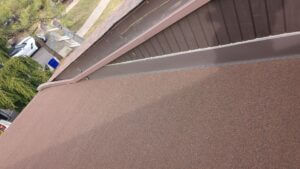Flashing Repair vs. Replacement: Understanding Roof Flashing
Lets Discuss Flashing Repair in NJ. Flashing is a thin, flat material installed around roof features like chimneys, vents, and skylights to prevent water from entering the structure. It’s usually made of aluminum, copper, or galvanized steel. Properly installed flashing is essential to prevent leaks and water damage in your home. If your roof flashing develops cracks or starts to deteriorate, it can lead to water infiltration, which can cause major issues such as mold and rot. Regular inspection of your roof flashing is crucial to identify any signs of damage early on, allowing you to address the issue promptly.

When you start spotting leaks in your ceiling or walls, see water stains on your ceilings, or notice your roof shingles near the flashing showing signs of wear, it might be time to think about fixing your flashing. Additionally, keep an eye out for rust or corrosion on the flashing, loose or missing sections, and any visible gaps or cracks. These are clear signals that your flashing needs attention to prevent any water damage to your roof or home.
Signs that indicate flashing repair is needed in NJ
Repairing your flashing can be a smart move to plug leaks and shield your roof from water damage, all without breaking the bank. By patching up damaged flashing, you’re essentially giving your roof a longer lease on life, sidestepping the need for a complete overhaul. Plus, it helps maintain your roof’s structural strength, keeping more serious issues at bay. It’s an investment that pays off in the long haul.
The Flashing Repair Process
Before diving into flashing repair, it’s important to grasp what’s involved in the process.
First off, there’s an inspection phase. This is where a thorough check of the flashing takes place, hunting for any signs of trouble like rust, corrosion, or loose bits.
Next up is removing any old, damaged flashing with care to avoid causing further harm to your roof.
Once that’s done, the area where the new flashing will go needs a good clean and prep to ensure a snug, waterproof fit.
Then comes the installation phase. The new flashing is carefully put in place and secured using the right fasteners and sealants.
Finally, it’s time for testing. We need to make sure the repair does its job and keeps the water out effectively.
Knowing the ins and outs of flashing repair is key when deciding if it’s the right fix for your roofing woes.
Materials Used for Flashing Repair
When it comes to repairing your flashing, there are a few materials the pros might use. Options include aluminum, copper, galvanized steel, and PVC plastic. Each material has its pros and cons, so the choice might depend on factors like cost, durability, and what your roof specifically needs. Just remember, the material you pick will affect how long the repair lasts and how well it holds up.
The Cost of Flashing Repair in NJ
Expect to shell out between $200 and $400 for flashing repair, depending on how extensive the damage is and what materials are needed. It’s often a more wallet-friendly option compared to replacing all the flashing outright. But keep in mind, costs can vary based on where you live and the expertise of the contractor you hire.
Contact Herts Roofing for a FREE Inspection to determine if you have questions
When to Think About Roof Flashing Replacement
If you’re seeing signs like rust, corrosion, or bending in your flashing, or if it’s not sealing properly around chimneys, vents, or skylights, it’s probably time to swap it out. And don’t ignore missing or cracked flashing either; replacing it ensures your roof stays in tip-top shape. Regular inspections are key for catching these issues early on.
Benefits of Roof Flashing Replacement in NJ
Replacing your roof flashing can work wonders for keeping leaks and water damage at bay. Here’s why it’s worth considering:
- Stops Leaks: Fresh flashing forms a better barrier against water, reducing the risk of leaks and damage to your home.
- Boosts Durability: Upgrading old flashing with new materials can beef up your roof’s overall strength and lifespan.
- Saves Energy: Tighter flashing means less air leakage, potentially improving your home’s energy efficiency.
- Enhances Appearance: New flashing can give your roof a facelift, upping its visual appeal and curb appeal.
Check out our Roof Flashing Replacement Process
Swapping out old flashing for new involves a few key steps:
- Assessment: First, the roofer checks out the existing flashing to see if it’s past its prime.
- Removal: If it’s time for a change, the old flashing gets carefully taken out.
- Prep: The area for the new flashing gets prepped and any needed repairs to the roof are made.
- Installation: The new flashing goes in using the right materials and techniques to keep water out.
- Sealing and Testing: Once installed, the new flashing gets sealed up tight to keep water from sneaking in, and everything gets tested to make sure it’s shipshape.
Remember, the exact process might vary based on your roof’s needs and what materials are being used.
In Conclusion: Choosing the Right Fix for Your Roof
Deciding whether to repair or replace your roof depends on a bunch of factors like how bad the damage is, how old your roof is, and what your budget looks like. Fixing up a few loose shingles or small leaks might be a quick and affordable fix. But if your roof’s seen better days or is nearing the end of its lifespan, a replacement could be the smarter long-term move. It keeps your roof strong and can save you from pricier repairs down the line. Always chat with a pro roofer to get the scoop on what’s best for your roof.




